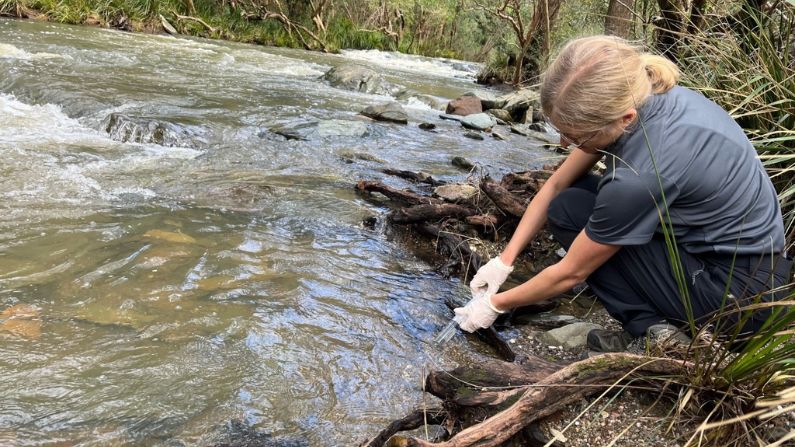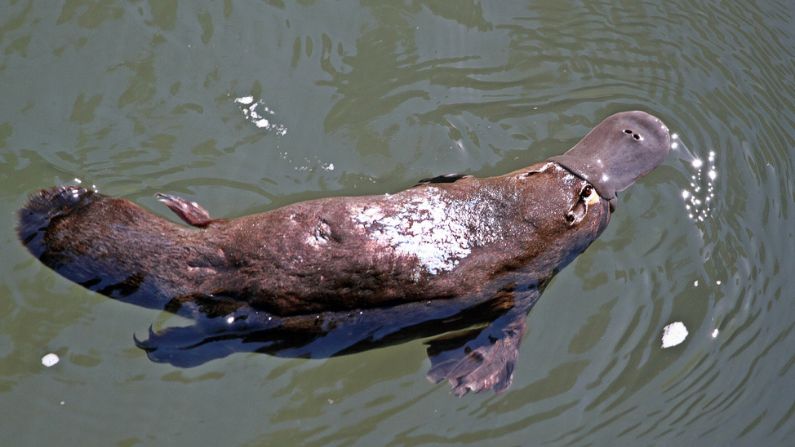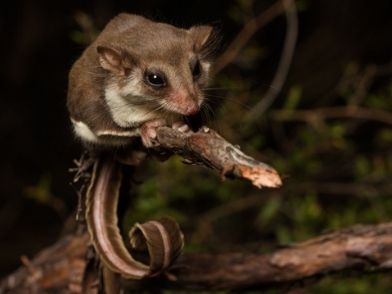Platypus
© Edwinna Bartley
The platypus belongs to the order Monotremata, meaning ‘one hole’ because it has a single opening for its excretory and reproductive systems. The platypus occurs only in Australia though similar fossils from 60 million years ago have been found in South America. Platypus populations occur throughout Tasmania and up the east coast of Victoria, New South Wales, and Queensland as far as Cooktown. The platypus is now extinct in South Australia though Kangaroo Island has an introduced population.
Quick facts
COMMON NAME:
Platypus
SCIENTIFIC NAME:
Ornithorhynchus anatinus
FAMILY:
Ornithorhynchidae
ALSO KNOWN AS:
The duck-billed platypus, boondaburra, mallangong or tambreet (Indigenous terms around Yas, Murrumbidgee and Tumat), or tohunbuck (Goomburra language, Darling Downs).
CONSERVATION STATUS:
The platypus’s conservation status is officially listed as “Near Threatened” both in Australia and internationally (as described in the IUCN Red List since 2016).
How we are helping platypuses
In addition, since 2009, Wildlife Queensland has campaigned for a ban on enclosed opera house-style nets in Queensland. Read more.
 © Tamielle Brunt
© Tamielle Brunt
Did you know?
The platypus is one of the few venomous mammals, the spur on the hindfoot delivers a poison capable of causing severe pain to humans. Platypuses are big eaters and have been recorded consuming the equivalent of 15–30 per cent of their total body weight in a day.
 © Neil Zoglauer
© Neil Zoglauer
Threats to the platypus
- Human impact on habitat and food sources:
- Waterways are under threat from dam construction, riverbank erosion, irrigation, chemical pollution and garbage.
- Platypuses are vulnerable to being caught in fishnets and traps as well as occasionally on fishing lines baited with worms.
- Foxes and cats.
- Loss of habitat makes isolated populations more vulnerable to decreased genetic diversity.
- Climate change causing drought and loss of habitat.
Home range
- Their home range is normally 2.5 ha but can be up to 15 ha.
- Generally travels up to 1 km along a stream but can travel up to 7 km.
Distribution
- Found in waterways all along the eastern edge of Australia, from Tasmania to the Arran River near Cooktown. Wildlife Queensland research suggests that in Queensland this is not one continuous population, but at least three discontinuous populations.
- Their range does not extend much past the Great Dividing Range in most areas but as far west as western Victoria.
Description
- Duck-like bill, broad flat tail and thick waterproof fur.
- Webbed front feet, partially webbed hind feet.
- Deep brown fur on its back and top of the head, golden or silky grey underneath.
- No external ear structure.
- Females average around 900 g and measure 43 cm long; males average 1.7 kg and measure 50 cm long (average size increases the further south the animal is found).
- The male has bony spurs on both hind legs for defence. These spurs are connected to a venom-producing gland in the thigh.
Signs
- Concentric rings appear on the surface of the water when platypus dive and when they feed on the surface.
- A trail of bubbles shows their progress underwater.
- A characteristic ‘bow-wave’ when swimming on the water surface.
- Burrow entrances in banks are typically 10–15 cm in diameter. The burrow entrance may be beneath the water surface or more commonly from 5 cm to 1 m above the water level and often hidden by overhanging vegetation.
- Well-worn slide mark from the burrow directly into the water.
- Characteristic footprints are sometimes left in the soft mud on the riverbank, especially near a burrow.
Habitat
- Freshwater streams, lakes or rivers, including artificial dams.
- Alpine to tropical areas.
Ecology
Life history and behaviour
- 12 years average life span in the wild.
- 15–over 20 years in captivity.
- Males fight over females in the mating season, using their venomous spurs on their rear legs as weapons.
- Territorial and solitary, platypuses do not live in social groups. Males are not involved in raising young.
- Platypuses have been known to migrate across paddocks and similar land to reach new home waterways.
Breeding
- The platypus (and echidna) are unique mammals because they lay eggs and feed their young through milk-producing spongy glands.
- Breeding season varies with location: recorded as mating in August in Queensland and October in Tasmania.
- Females first mate aged 2 years, some wait until they are 5.
- 1 litter in Spring of 1–2 eggs (may not reproduce every year).
- Incubation period 10–11 days during which the female holds them against her belly with her tail.
- Newborn platypuses are around 1.5cm long, are weaned at 4–5 months and remain in the burrow until they reach about 80 per cent of adult weight at about 6 months.
Food
- Carnivorous diet of fish eggs, worms, insects, crustaceans, molluscs, and tadpoles, plus larvae of caddisflies, mayflies, two-winged flies and shrimps.
- Feed almost totally in the water and mainly on bottom-dwelling prey.
- Feed mostly in the early morning and evening.
- Closes its eyes and ears when diving for food but receives information through the bill that navigates and locates prey in the water.
- The bill contains two types of electroreceptors: one senses touch, and the other senses electric currents produced by the muscle contractions of prey.
- Foraging platypuses stay underwater for up to one minute. All food is eaten on the surface.
More information
Websites
- Wildlife Queensland PlatypusWatch Network
- Australian Platypus Conservancy
- Upper Wimmera Landcare Group, Project Platypus
- Department of Environment and Science Queensland
- NSW National Parks and Wildlife Service
- Wild Watch Australia




